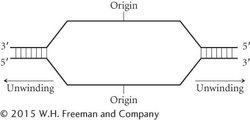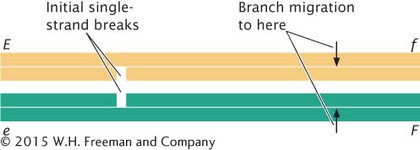APPLICATION QUESTIONS AND PROBLEMS
Question 16
16.Suppose that a future scientist explores a distant planet and discovers a novel form of double-
Question 17
17.Phosphorus is required to synthesize the deoxyribonucleoside triphosphates used in DNA replication. A geneticist grows some E. coli in a medium containing nonradioactive phosphorus for many generations. A sample of the bacteria is then transferred to a medium that contains a radioactive isotope of phosphorus (32P). Samples of the bacteria are removed immediately after the transfer and after one and two rounds of replication. Assume that newly synthesized DNA contains 32P and that the original DNA contains nonradioactive phosphorus. What will be the distribution of radioactivity in the DNA of the bacteria in each sample? Will radioactivity be detected in neither strand, one strand, or both strands of the DNA?
Question 18
*18.A line of mouse cells is grown for many generations in a medium with 15N. Cells in G1 are then switched to a new medium that contains 14N. Draw a pair of homologous chromosomes from these cells at the following stages, showing the two strands of DNA molecules found in the chromosomes. Use different colors to represent strands with 14N and 15N. (See Chapter 2 for a review of the stages of the cell cycle and meiosis.)
Cells in G1, before switching to medium with 14N
Cells in G2, after switching to medium with 14N
Cells in anaphase of mitosis, after switching to medium with 14N
Cells in metaphase I of meiosis, after switching to medium with 14N
Cells in anaphase II of meiosis, after switching to medium with 14N
Question 19
*19.A circular molecule of DNA contains 1 million base pairs. If the rate of DNA synthesis at a replication fork is 100,000 nucleotides per minute, how much time will theta replication require to completely replicate the molecule, assuming that theta replication is bidirectional?
Question 20
20.A bacterium synthesizes DNA at each replication fork at a rate of 1000 nucleotides per second. If this bacterium completely replicates its circular chromosome by theta replication in 30 minutes, how many base pairs of DNA will its chromosome contain?
Question 21
21.In Figure 9.7, which is the leading strand and which is the lagging strand?
Question 22
*22.The following diagram represents a DNA molecule that is undergoing replication. Draw in the strands of newly synthesized DNA and identify (a) through (d):
Polarity of newly synthesized strands
Leading and lagging strands
Okazaki fragments
RNA primers

Question 23
*23.What would be the effect on DNA replication of mutations that destroyed each of the following activities of DNA polymerase I?
3′→5′ exonuclease activity
5′→3′ exonuclease activity
5′→3′ polymerase activity
Question 24
24.How would DNA replication be affected in a bacterial cell that is lacking DNA gyrase?
Question 25
*25.DNA polymerases are not able to prime replication, yet primase and other RNA polymerases can. Some geneticists have speculated that the inability of DNA polymerase to prime replication is due to its proofreading function. This hypothesis argues that proofreading is essential for the faithful transmission of genetic information and that, because DNA polymerases have evolved the ability to proofread, they cannot prime DNA synthesis. Explain why proofreading and priming functions in the same enzyme might be incompatible.
Question 26
26.Arrange the following components of replication in the order in which they first act in the replication process: ligase, DNA polymerase I, helicase, gyrase, primase, single-
Question 27
27.A number of scientists who study cancer treatment have become interested in telomerase. Why? How might anticancer therapies that target telomerase work?
Question 28
*28.The enzyme telomerase is part protein and part RNA. What would be the most likely effect of deleting the gene that encodes the RNA part of telomerase? How would the function of telomerase be affected?
Question 29
29. Dyskeratosis congenita (DKC) is a rare genetic disorder characterized by abnormal fingernails and skin pigmentation, the formation of white patches on the tongue and cheek, and progressive failure of the bone marrow. An autosomal dominant form of DKC results from mutations in the gene that encodes the RNA component of telomerase. Tom Vulliamy and his colleagues examined 15 families with autosomal dominant DKC (T. Vulliamy et al. 2004. Nature Genetics 36:447–449). They observed that the median age of onset of DKC in parents was 37 years, whereas the median age of onset in the children of affected parents was 14.5 years. Thus, DKC in these families arose at progressively younger ages in successive generations, a phenomenon known as anticipation. The researchers measured the telomere length of members of these families; the measurements are given in accompanying table. Telomeres normally shorten with age, so telomere length was adjusted for age. Note that the age-
Dyskeratosis congenita (DKC) is a rare genetic disorder characterized by abnormal fingernails and skin pigmentation, the formation of white patches on the tongue and cheek, and progressive failure of the bone marrow. An autosomal dominant form of DKC results from mutations in the gene that encodes the RNA component of telomerase. Tom Vulliamy and his colleagues examined 15 families with autosomal dominant DKC (T. Vulliamy et al. 2004. Nature Genetics 36:447–449). They observed that the median age of onset of DKC in parents was 37 years, whereas the median age of onset in the children of affected parents was 14.5 years. Thus, DKC in these families arose at progressively younger ages in successive generations, a phenomenon known as anticipation. The researchers measured the telomere length of members of these families; the measurements are given in accompanying table. Telomeres normally shorten with age, so telomere length was adjusted for age. Note that the age-
How does the telomere length of the parents compare with the telomere length of the children? (Hint: Calculate the average telomere length of all parents and the average telomere length of all children.)
Explain why the telomeres of people with DKC are shorter than normal.
Explain why DKC arises at an earlier age in subsequent generations.
| Parent telomere length | Child telomere length |
|---|---|
| –4.7 | –6.1 |
| –6.6 | |
| –6.0 | |
| –3.9 | –0.6 |
| –1.4 | –2.2 |
| –5.2 | –5.4 |
| –2.2 | –3.6 |
| –4.4 | –2.0 |
| –4.3 | –6.8 |
| –5.0 | –3.8 |
| –5.3 | –6.4 |
| –0.6 | –2.5 |
| –1.3 | –5.1 |
| –3.9 | |
| –4.2 | –5.9 |
Question 30
30.An individual is heterozygous at two loci (Ee Ff), and the two genes are in repulsion (see Chapter 5). Assume that single-
